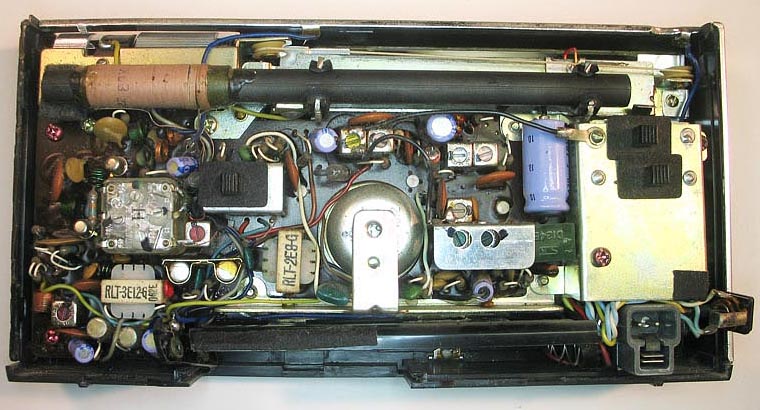


This radio, branded Krysler, appeared under several different brand names during the early 1960s. I purchased this one on EBay when the seller offered a price I couldn't refuse. It was in excellent working and cosmetic condition, except the badge was missing from the top center of the radio.
I found images online of other Krysler transistor radios that all had a badge with stars and fleur-de-lis on a quartered shield. I made a copy to fit and glued it in place. Later, I discovered that the ten transistor version of the Krysler radio had a different badge, but I haven't been able to find a good copy to make a reproduction, so I left the incorrect one in place for now.
Ten transistors is overkill in this radio, and most likely were simply added because at the time consumers believed that the more transistors, the better the radio, much like today's consumers think that the more pixels a camera has, the better it is. For a pocket transistor AM radio of this type, six transistors is more than adequate.
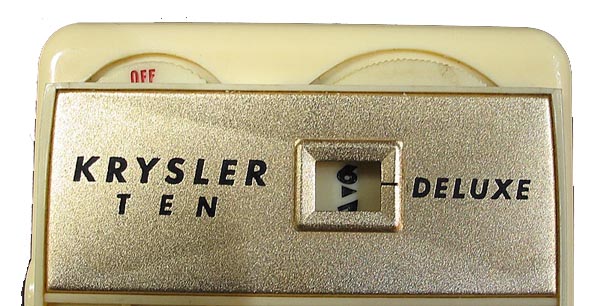
Nevertheless, this is a very sensitive radio with decent sound, and no electronic restoration was necessary. It uses a 9 volt battery.
The design is attractive, with nicely engraved metal trim. The dial scale still has the Conelrad markers between 600 and 800 KC and 1000 and 1400 KC.
Conelrad was replaced by the Emergency Broadcast System in August, 1963, and the Civil Defense station markers were dropped from radio dials. The EBS system was in turn replaced in January, 1997 by the Emergency Alert System (EAS).

I picked up this beautifully styled Art Deco Philco transistor radio for virtually nothing at a ham radio fest. The radio played as found. This is Philco's first transistor radio. The model number is missing from the label inside, so I don't know if it is a Code 124 or 126. A seven transistor radio, it plays well with decent sound and reception.
This has to be one of the most elegant transistor radios ever designed.
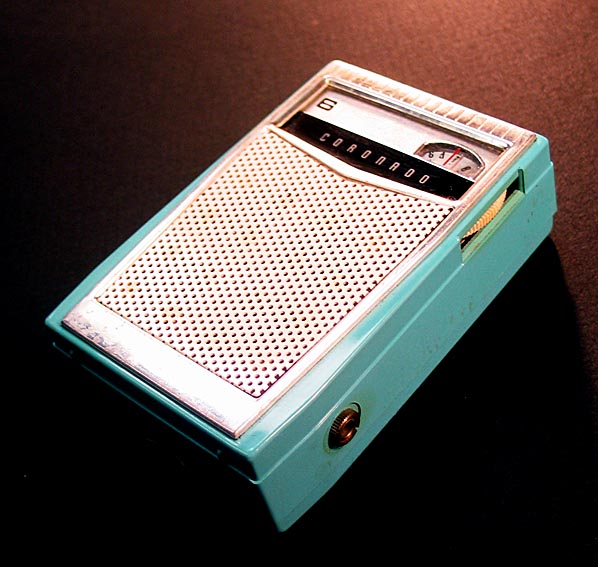
Coronado was a house brand for the mid-west Gamble-Skogmo department store chain. They sold a line of tube radios made by various manufacturers over the years, but I wasn't aware they also sold transistor radios under the Coronado brand. This is an American made six transistor AM shirt pocket size radio, and I'm pretty sure that the radio was made by Arvin, a well known manufacturer of transistor radios that are collectible as well.
Bunis lists this radio, model RA44-9914A, as 1963 production, which makes it somewhat unique. Most US companies were selling transistor radios made in Japan or Hong Kong by the late 1950's. Finding a US made transistor radio from 1963 is pretty uncommon. Zenith was still producing radios in the US in the early '60's, but before long, even they gave up and sent radio production overseas.
The radio uses a 9-volt battery that is no longer made. I could easily install a modern 9-volt snap connector, and may do so in the future. To test the radio, I fed a 9-volt power source to the original battery clips, and the radio plays nicely, with good volume and sensitivity, although the dial indicator is off quite a bit. I don't know if that is an alignment issue or the dial just wasn't very accurate to begin with.
I found this radio on eBay, and the seller said that his wife was the original owner of the radio. It also came with the original leather case and earphone plug.

I found this nice example of the GE P-808 transistor radios in an antique shop in Utah on a recent trip out west. I had to do some haggling to get it at $25. It also has the leather cover, although one snap is missing. This is a five transistor radio, and uses a high impedance speaker (no audio transformer). It plays very well as found, so the only modification I've done is to replace the battery connector with a modern 9-volt snap connector.

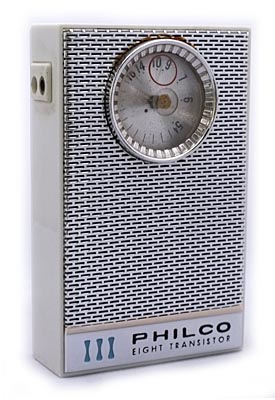
This stylish Japanese made radio branded for Philco plays, but with much whistling and chirping. It is currently a shelf queen waiting for restoration. As as says on the front, it's an eight transistor radio. Model number is NT-802WHG, and it uses a 9-volt battery. I found this radio at a hamfest flea market.

This Sanritsu manufactured Japanese radio appeared under several different brands, Spica being one of the more commonly found ones. The cloissone dial finial is pretty beat up on this example, but some can be found in very nice condition. The designs are not always the same. The radio uses four AA batteries in series, and does play. I found in in a thrift store.
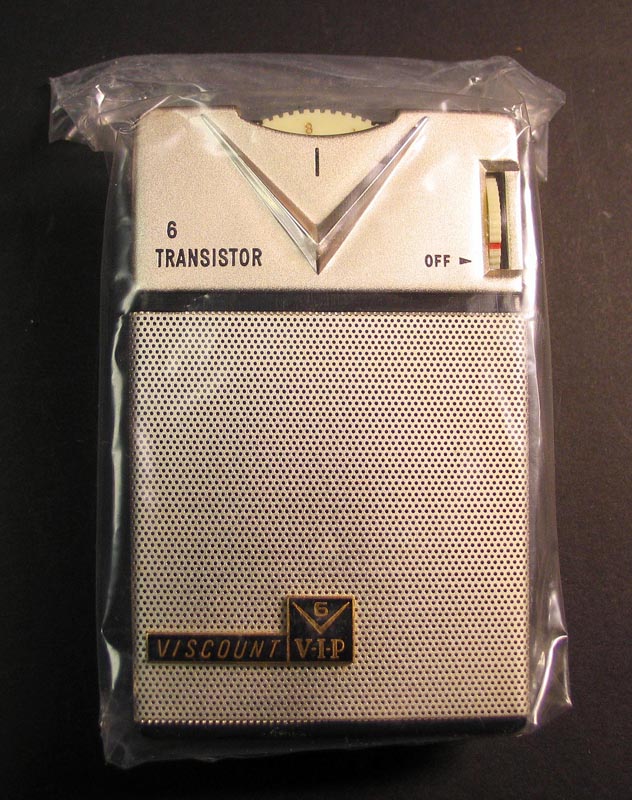
I really like the styling of Japanese pocket radios of the late 1950's and early 1960's. They featured nice metal and chrome accents with designs echoing design elements of American cars of the era. I found this 1960 Viscount radio on eBay. It is still sealed in plastic in its original box. Since I don't plan to remove the radio from its bag, I don't know how well it might play.
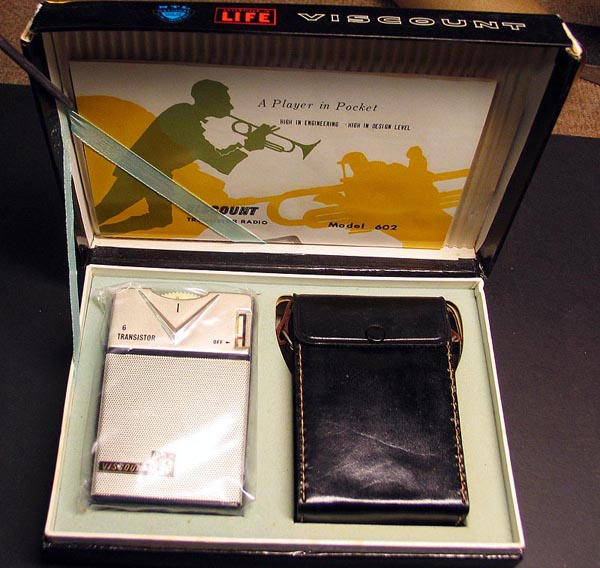
These radios came in several different styles, four of which are illustrated in Norman Smith's Transistor Radios, 1954-1968.

I found this nice little radio in an antique store. When I first spotted it, I thought it was a 2-transistor Boys' Radio. It was very clean and showing very little wear. It picked up one station at low volume in the shop.
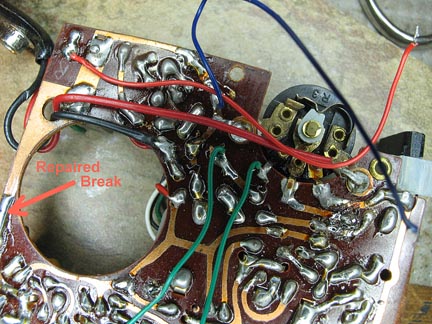 I tried researching the radio online, but only got one hit Googling "Stacy transistor radio," which was an image of the same model for sale on ETSY for $18.50. I couldn't find it listed in either the Buris "Tranistor Radios" book or Norman Smith's "Tansistor Radios 1954-1968" book. However, I did find two identical radios in Smith's book, one branded "Mayfair" and the other "Honey Tone."
I tried researching the radio online, but only got one hit Googling "Stacy transistor radio," which was an image of the same model for sale on ETSY for $18.50. I couldn't find it listed in either the Buris "Tranistor Radios" book or Norman Smith's "Tansistor Radios 1954-1968" book. However, I did find two identical radios in Smith's book, one branded "Mayfair" and the other "Honey Tone."
Recapping this radio was not easy. The radio only measures 4" x 2-1/4" x 1-1/8," and the PCB is about 3/4's that size. It was very difficult to determine where the cap terminals were on the trace side of the PCB. Solder flowed between the traces and I had to do some cleanup to prevent shorting between them. I checked the radio after I replaced each cap to make sure everything was still working ok, and still managed to break the PCB board. I reflowed the solder over the break (photo, right). I eventually had to go back and run a jumper and reinforce the back as it would crack again whenever I tried to install the 9-volt battery.

I removed the plastic labels on the old caps and slid them over the new caps (photo below, center). They weren't an exact fit, but they disguise the new caps somewhat.
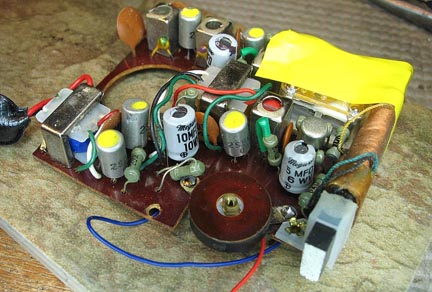 I have not yet determined which Japanese company manufactured this radio, which appeared under at least three different brand names. I would guess that it dates from the 1958-1962 period. The radio plays well, with great volume, and it picks up the all the local AM stations. It also has a leather case in very nice condition.
I have not yet determined which Japanese company manufactured this radio, which appeared under at least three different brand names. I would guess that it dates from the 1958-1962 period. The radio plays well, with great volume, and it picks up the all the local AM stations. It also has a leather case in very nice condition.

ca 1960 Cosmos-B 2-Transistor Boy's Radio
I found this Boy's Radio in an antique store. The radio had been dropped at some point in its past and the case was badly damaged. A large chunk was missing from the back cover and the front had several large cracks and one corner was complete separated. The radio did play, however.
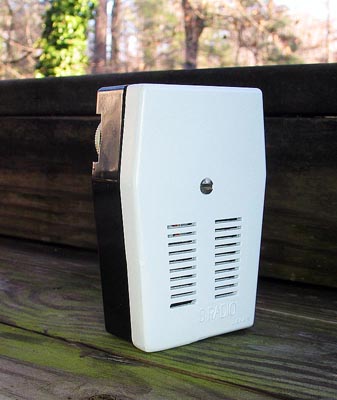 Although Norman Smith in Transistor Radios dates the radio to 1958, several other sources argue that Boy's Radios weren't on the market until about 1960. Boy's Radios were two-transistor radios that were developed to evade import quotas by qualifying as toys marketed to children. And they were often bought as gifts for kids, often their first transistor radio. They have become highly collectible due to their stunning colors and beautiful styling, although the Cosmos-B shown here is rather plain. With only two transistors, the radios weren't particulary great performing radios.
Although Norman Smith in Transistor Radios dates the radio to 1958, several other sources argue that Boy's Radios weren't on the market until about 1960. Boy's Radios were two-transistor radios that were developed to evade import quotas by qualifying as toys marketed to children. And they were often bought as gifts for kids, often their first transistor radio. They have become highly collectible due to their stunning colors and beautiful styling, although the Cosmos-B shown here is rather plain. With only two transistors, the radios weren't particulary great performing radios.
Rescuing this radio consisted of repairing the case. The front half of the case I repaired by gluing the broken section together with CA (superglue) and reinforcing the joint with J-B Weld. The remaining cracks in the front were stabilized by reinforcing them from behind with J-B Weld.

The back half of the case was a much more difficult problem. I used scraps of styrene plastic to re-create the missing corner. I used J-B Weld to provide strength and spot glazing putty to fill in the cracks and joints. Then I primed and repainted the back half of the radio.
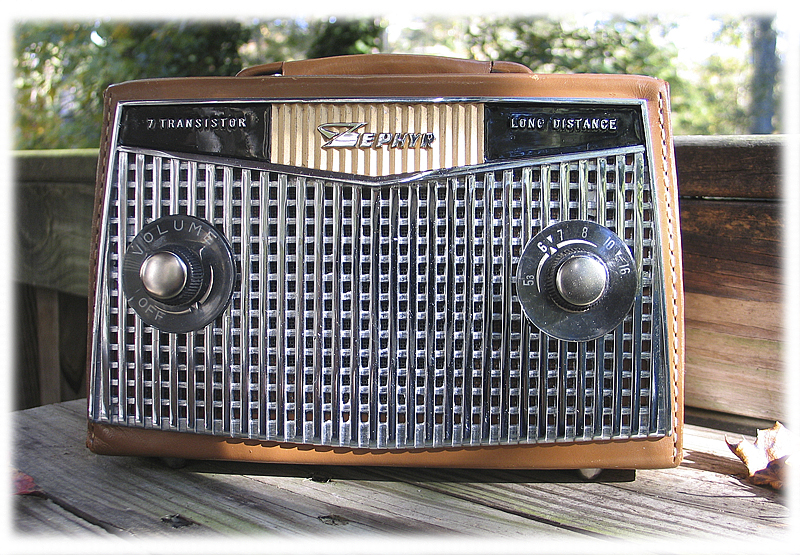
At first glance, this radio appears to be a cheap Asian knockoff of the Zenith 700 transistor radio of that era, but it is actually a very well built quality radio made in Hong Kong. Zephyr pocket transistor radios from Japan and Hong Kong are well known to collectors and highly desired. This lunchbox style radio, however, is the only one I have ever seen, and I am not sure of the date of production. Zenith produced a highly popular and successful line of radios in this style from 1958 through the mid-60's, and the look was widely imitated by many radio manufacturers.
Hong Kong Zephyr radios were made primarily with Japanese parts. In 1962, Japan, concerned that Hong Kong radio exports were eating into their marketplace dominance, banned the export of transistors to Hong Kong for a short while. During this period, Zephyr purchased transistors from the UK and the US. This radio appears to have transistors made by Texas Instruments, so it may have been made during the period when Japanese transistors were unavailable in 1962.
I found this radio in a second hand store in Cedar City, Utah. As found it did not play. There were a couple loose wires inside. I was never able to find a schematic for it, but decided to go ahead and see if I could get it playing. The first step was to replace all the electrolytic capacitors. Fortunately, I was not only able to read the values of the capacitors, but the polarity was plainly marked on each cap. All the caps were common and Radio Shack carried replacements. The 28 gauge wiring was oxidized at the PCB joints and those that weren't already broken got broken in handling, so I ended up replacing all the wiring with 24 gauge wire. I also disassembled and cleaned the volume control/off-on switch. After recapping, the radio still did not play, but that just turned out to be a defective ear phone jack. I replaced the ear phone jack and the radio played beautifully.
 The radio is intended to be powered with six C cells. However, when I had the chassis on the bench, I used a 9-volt cell to power it, and I added a 9-volt snap connector so I could continue using a 9-volt cell to power the radio, which is more convenient, and less expensive than using six C cells. The radio weighs a lot less, too.
The radio is intended to be powered with six C cells. However, when I had the chassis on the bench, I used a 9-volt cell to power it, and I added a 9-volt snap connector so I could continue using a 9-volt cell to power the radio, which is more convenient, and less expensive than using six C cells. The radio weighs a lot less, too.
Left is a view of the PCB before recapping showing the Texas Instruments transistors. The transistors are not branded, but the part numbers correspond to TI product. These may have been transistors that did not fully meet TI specs and were sold at reduced prices to Zephyr and other radio manufacturers.
The genuine leather case is in good condition, but I did some repairs to the stitching which was coming loose in places. One snap fastener in the back was missing, so I replaced both with new fasteners. Finally, I cleaned and polished the leather. The front grille is nicely chromed heavy metal, and the top area with the Zephyr logo is enamelled, not painted. As I mentioned earlier, the build quality of this radio is impressive, and it is a good performer.

A 99¢ eBay find, this radio came untested and with an old Mallory Duracell 4-volt battery inside. This is a very early example of a US made transistor radio, and would have competed with the Regency TR series, GE's 675 series, and early Zenith 500s. The AM-5 was Magnavox's second model transistor radio, following the 1955 AM-2, which is identical externally. The only difference is that the AM-5 uses a printed circuit board chassis. The AM-2 was handwired on a metal chassis. Magnavox products were very high quality products up through the early 1970's, and the quality of this radio is quite evident in its construction and performance.
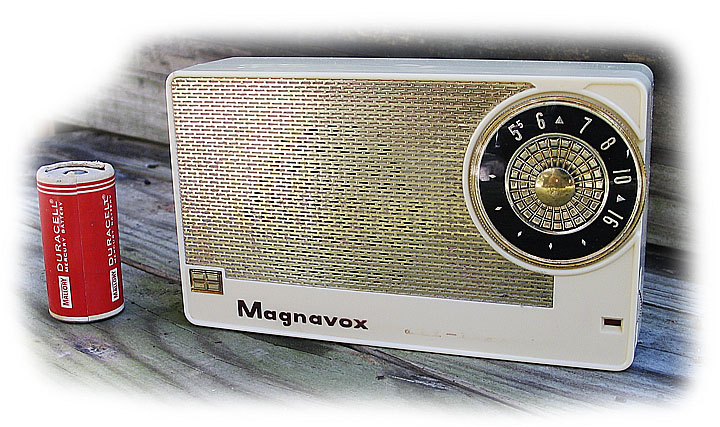
I applied power to the radio from a 3 volt power supply, and the radio worked, but with very weak volume. I then disassembled the radio and replaced the five electrolytic capacitors, and now the radio plays with good volume and sensitivity, picking up all the AM stations in the area. Like most of these early small transistor radios, the volume control is worn out, and is very scratchy when turned, but once adjusted the sound is excellent for this size radio.
I cleaned the case with Novus plastic cleaner and re-assembled the radio. I made a battery for it by taping three AAA cells together and wiring them in series. The battery pack is then soldered to the original positive and negative terminals. There's plenty of room in the battery compartment for the three cells, although changing out the batteries will be somewhat inconvenient.
Want to hear it play? Click here!


The world's first shirt-pocket transistor radio was the Regency TR-1, introduced in October, 1954. Texas Instruments was an early developer of the transistor, and they designed the Regency TR-1 to create a product for their transistors. These radios are relatively rare and command high prices.

The second shirt-pocket radio introducted in August, 1955, was the GE Model 676. The P790A, shown above left, appears to be a direct descendent of the original GE shirt pocket radios of 1955. Comparing the P790 with the French language GE Model 675 advertisement above right, the family resemblance is unmistakeable. The P790 is a little more square than the more attractive original models 675 and 676, which imitated somewhat the style of the Regency TR-1. The on/off/volume switch has also been relocated from the top to the bottom of the radio. The left-hand speaker location and recessed dial knob, however, have been carried through from the original design.
The original GE featured a five transistor chassis, and the later P790 had six. The radio is currently unrestored, so I don't know how well it performs, but it is probably very similar to the Magnavox AM-5 above.

This radio came as a Christmas present from my daughter and son-in-law. They found it in an antique shop in Hebron, Illinois. I have not been able to find any information on this radio. The radio works and is in very nice cosmetic condition

I don't know much about this nicely styled Panasonic radio. It is another radio that belonged to my Dad and I recently ran across it in a desk drawer. The battery holder was broken and needed re-gluing. Otherwise, a good cleaning and fresh batteries and it plays very well on AM and FM. Sensitivity is good, but I would judge the audio quality just average. It features thumbwheel controls for the tuning and on/off/volume. A small momentary contact button on the left below the dial scale activates a dial light for tuning in the dark. My Dad made the red reference mark on the dial scale to find some favorite station. The "leatherette" look case is actually plastic, with lots of chrome trim. The radio is well constructed, both inside and out, and has a solid feel.

